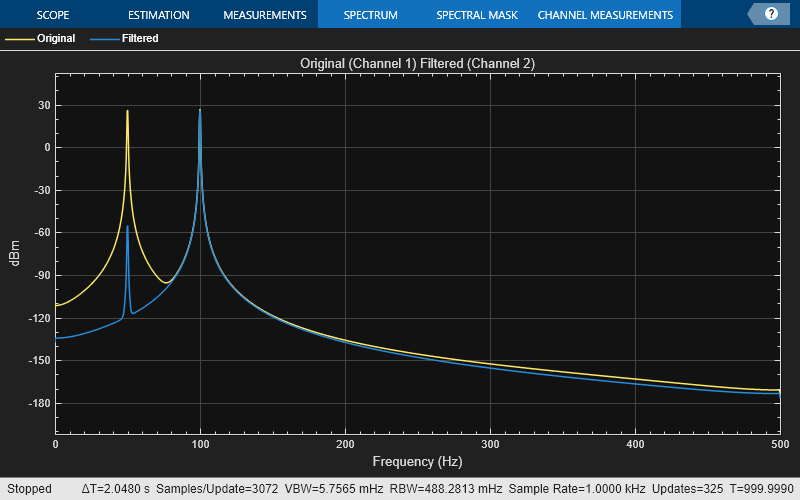dsp.CoupledAllpassFilter
Coupled allpass IIR filter
Description
The dsp.CoupledAllpassFilter object implements a coupled allpass filter
structure composed of two allpass filters connected in parallel. Each allpass branch can
contain multiple sections. The overall filter output is computed by adding the output of the
two respective branches. An optional second output can also be returned, which is power
complementary to the first. For example, from the frequency domain perspective, if the first
output implements a lowpass filter, the second output implements the power complementary
highpass filter. For real signals, the power complementary output is computed by subtracting
the output of the second branch from the first. dsp.CoupledAllpassFilter
supports double- and single-precision floating point and allows you to choose between
different realization structures. This System object™ also supports complex coefficients, multichannel variable length input, and
tunable filter coefficient values.
To filter each channel of the input:
Create the
dsp.CoupledAllpassFilterobject and set its properties.Call the object with arguments, as if it were a function.
To learn more about how System objects work, see What Are System Objects?
Creation
Syntax
Description
caf = dsp.CoupledAllpassFiltercaf, that filters each channel of the input signal
independently. The coupled allpass filter uses the default inner structures and
coefficients.
caf = dsp.CoupledAllpassFilter(AllpassCoeffs1,AllpassCoeffs2)caf, with
Structure set to "Minimum
multiplier", AllpassCoefficients1 set
to AllpassCoeffs1, and
AllpassCoefficients2 set to
AllpassCoeffs2.
caf = dsp.CoupledAllpassFilter(struc,AllpassCoeffs1,AllpassCoeffs2)caf, with
Structure set to struc and
the relevant coefficients set to AllpassCoeffs1 and
AllpassCoeffs2. struc can be
"Minimum multiplier", "Wave Digital
Filter", "Lattice".
caf = dsp.CoupledAllpassFilter(
sets properties using one or more name-value arguments. For example,
to specify the independent branch 1 phase gain as "-1", set
Name=Value)Gain1 to "-1".
Properties
Usage
Description
Input Arguments
Output Arguments
Object Functions
To use an object function, specify the
System object as the first input argument. For
example, to release system resources of a System object named obj, use
this syntax:
release(obj)
Examples
Algorithms
The following three figures summarize the main structures supported
by dsp.CoupledAllpassFilter.
Minimum Multiplier and WDF

Lattice

Lattice with Complex Conjugate Coefficients

References
[1] Regalia, Philip A., Mitra, Sanjit K., and P.P Vaidyanathan “ The Digital All-Pass Filter: A Versatile Signal Processing Building Block.” Proceedings of the IEEE 1988, Vol. 76, No. 1, pp. 19–37.
[2] Mitra, Sanjit K., and James F. Kaiser, "Handbook for Digital Signal Processing" New York: John Wiley & Sons, 1993.
Version History
Introduced in R2013b

